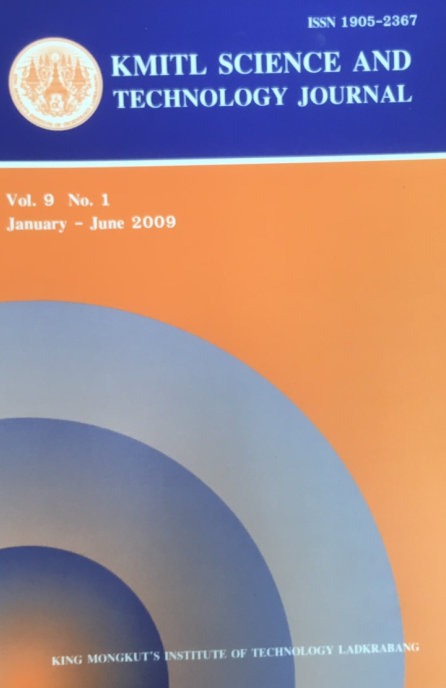Application of Multi-level Electromagnetic Fields for Removal of Algae Bloom (Euglena sanguinea)
Main Article Content
Abstract
The objective of this research was to study a technique for removal of algae bloom (Euglena sanguinea) by using multi-level electromagnetic fields (MLEMF). With this technique, an electrical power was changed to be an electric field by an electronic control. An electron was transferred by electric field. The experiment was stimulated in a 10 L lab scale. The voltage of system could be adjustable from 0 to 60 Vac and frequency was 10 kHz. The research aimed to study the physical, biological, and chemical properties of water. After treating by MLEMF, it was found that the membrane crashed and collapsed even the organs deformed. Moreover, treatment efficiencies of SS, turbidity, COD, TN and TP represented to 89%, 96%, 73%, 67%, and 94%, respectively. The reaction of algae bloom removal was related to concentration of algae according to time followed by the first order reaction with a rate constant of 0.0004 s -1. This technique can be applied in the production of new water supply process. The advantage
of this technique is no chemical involved. MLEMF technology proposes clean water without chemical color residues.
Key words: Multi-level electromagnetic fields (MLEMF), algae bloom, Euglena sanguinea, electric current, voltage
* Corresponding author: E-mail: s6060202@kmitl.ac.th
Article Details
Copyright Transfer Statement
The copyright of this article is transferred to Current Applied Science and Technology journal with effect if and when the article is accepted for publication. The copyright transfer covers the exclusive right to reproduce and distribute the article, including reprints, translations, photographic reproductions, electronic form (offline, online) or any other reproductions of similar nature.
The author warrants that this contribution is original and that he/she has full power to make this grant. The author signs for and accepts responsibility for releasing this material on behalf of any and all co-authors.
Here is the link for download: Copyright transfer form.pdf
References
removal of Microcystis aeruginosa, Ultrasonic Sonochemistry, 13, 446-450.
[2] Zimba, P. V., Rowan, M. and Triemer, R. 2004. Identification of euglenoid algae that
produce ichthyotoxin (s), Journal of Fish Diseases, 27, 115-117.
[3] Ma, J. and Liu, W. 2002. Effectiveness and mechanism of potassium ferrate (VI)
preoxidation for algae removal by coagulation, Water Res, 36, 871-878.
[4] Petruševski, B., van Breemen A. N. and Alaerts, G. 1996. Effect of permanganate
pretreatment and coagulation with dual coagulants on algae removal in direct filtration,
J. Water Supply Res. Technol. –AQUA, 45, 316-326.
[5] Steynberg, M. C., Gugleilm, M. M., Geldenhuys, J. C. and Pieterse, A. J. H. 1995.
Chlorine and chlorine dioxide: pre-oxidants used as algocide in potable water plants, J.
Water Supply Res. Technol. – AQUA, 45, , 162-170.
[6] Zou, H., Pan, G. amd Chen, H. 2006. Removal of cyanobacterial blooms in Taihu Lake
using local soils. II. Effective removal of Microcystis aeruginosa using local soils and
sediments modified by chitosan, Environmental Pollution, 141, 201-205.
[7] Heng, L., Jun, N., Wen-jie, H. and Guibai, L. 2009. Algae removal by ultrasonic
irradiation-coagulation, Desalination, 239, 191-197.
[8] Pan, G., Chen H., and Yuan, X. 2005. Removal of harmful cyanobacterial blooms in
Taihu Lake using local soils. III. Factors affecting the removal efficiency and an situ
field experiment using chitosan-modified local soils, Environmental Pollution, 141, 206-
212.
[9] American Health Association, American Water Works Association, Water Environment
Federation. 1998. Standard methods for the examination of waste water and wastewater,
20th Ed. Washington DC.
[10] Reynolds, C. S. 1884. The ecology of freshwater phytoplankton: Cambridge University
Press, Cambridge, U. K.
[11] www.chimie.unbuc.ro/biblioteca/anale/2002b/127-134.pdf.
[12] Scott, K. 1991. Electrochemical reaction engineering. Academic Press, Toronto.
[13] Robert L. B. 1990. Introductory Circuit Analysis. Sixth ed. Macmillan Publishing
Company, New York.
[14] Packamwongsang, K., Nopanakeepong, S. and Pheawbang, P. 2008. Evaluation of
Complex Impedance and Equivalent Circuit of Euglena Sanguinea Ehrenberg with
Electromagnetic multi-level. The 31st Electrical Engineering Conference (EECON-31),
Nakornnayok, Thailand.
[15] Fraga, F. and Pérez, F. 1990. Transformaciones entre composición química del
fitoplancton. composición elemental yrelación de Redifield, Sci. Mar, 54(1), 69-76.


